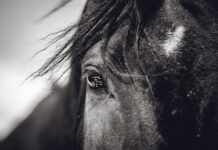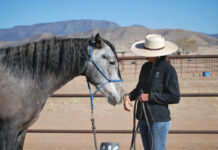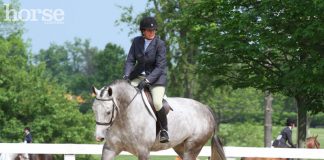
If you have a young horse or a horse that is brand new to jumping, it’s important to carefully introduce him to the sport so he will jump correctly and be confident over fences for the rest of his career. Christy Mackaness, an active eventing instructor and trainer based in Charleston, S.C., specializes in training young horses, and off-track Thoroughbreds in particular. Here, she shares her program for starting horses down the correct jumping path.
Flatwork Basics
Mackaness reiterates how important it is that when she puts her leg on a horse, he responds immediately, and that when she asks the horse to wait, he listens. “[These actions and reactions] are the core to building confidence and trust,” she explains.
Mackaness also recommends that a horse have a basic understanding of the canter under saddle, though he need not be perfect with leads or canter departs, but when asked to canter, the horse should go forward willingly. “The foundation built in early flatwork is critical for a successful start over fences,” she says. “They won’t have a firm understanding of balance and straightness, but I expect them to have already started to understand the concept of staying between my leg and hand.” The horse is not leaning to either side against one of your legs or leaning on your hands; he is straight through his neck and shoulder so both reins feel even.
Also, cantering when asked will play a key role in engaging after the fence. The “getaway,” or strides a horse takes upon landing from the fence, should add confidence as the horse understands to go forward when leg is applied.

A green horse should be able to canter forward willingly under saddle before learning to jump.
Keep it Simple
When the key riding pieces are in place on the flat, Mackaness will outfit her horse in a properly fitted saddle, a plain cavesson and simple bit. If the horse is prone to rearing or flips his head, she will put on a loose-fitting standing martingale to stop that habit before it becomes ingrained. Mackaness does not put boots on a horse that is learning to jump; she wants him to feel the fence if he hits it so he learns to pick up his legs.
The type of poles used when teaching a horse to jump are of particular importance. “Solid wood is a must,” says Mackaness.
“The horses have to feel and respect the jump.” While she doesn’t use anything too complicated or scary (such as brightly painted panels or solid-looking stone walls), small logs and boxes are less-intimidating items to keep the horse engaged without startling him. There is no need to rush a horse that is learning to jump. “Slow and steady builds long-term confidence,” says Mackaness.
Eventually her horses will move up to jumping wider and more solid fences, but Mackaness lets each horse dictate the pace she takes with him. Some horses are naturally brave and game, taking her to the fences, while other horses need to be encouraged and reminded that they are capable of what she is asking.
Exercises for Impulsion and Straightness
Mackaness doesn’t drill her mounts on jumping; she works them for only 10 to 15 minutes at a time over fences, with lots of slow repetition built into the training session. “The easier and more exciting you make it, the more likely they will want to do it again,” she says. To keep a new-to-jumping horse’s interest and to instill both basics and confidence, Mackaness utilizes the following exercises.
Single Poles on the Ground
Though seemingly very simple, single poles on the ground allow a horse to learn to decipher the questions larger fences will ask later on in their jumping careers.
Ask your horse to walk, trot and canter straight over the pole and halt afterward. This allows you to reinforce the concept of straightness both before and after the fence. Focus on always riding the horse to the center of the pole, not drifting off-center. Enforcing this when the question is simply poles on the ground will help your horse understand that the center of the obstacle is the place he will be asked to jump each time.
Once your horse can quietly and confidently approach the pole on the ground in different gaits and is respectful of what you’re asking, you can make a small crossrail.
Crossrails
Ride your horse back and forth over the crossrail at a trot a few times until he understands that he’s being asked to lift his legs over the fence.
With a smaller crossrail, he might not offer a true jumping effort as he steps with each leg individually to get to the other side of the fence. Even the smallest jumping efforts must be rewarded with praise and a pat. Once your horse is successfully picking up his legs and cantering away from the fence, take him back to a trot and approach the fence again.
The getaway from the fence should be forward. Green horses often land in a heap or will decelerate from the effort of the jump. If you find your horse doing this, Mackaness recommends putting your leg on at landing to encourage the horse to go forward and develop impulsion. This is particularly important as the jumps get bigger and more hind-end strength is needed.
It’s important to note that a light hand is required as a horse learns to pick up his legs, Mackaness advises. If you support him too much, the horse will get heavy on the forehand and learn to lean on you. “Let your horse fumble on his own while you’re fairly light but confident on his back,” she says. “Just add leg and get to the other side.” This, she notes, is another reason why requiring responsiveness off the leg in early training is important.
Change of Direction
Next, Mackaness works on approaching the fence from both directions and changing directions after the fence, but she’s careful not to turn too soon upon landing.
“Riding straight after the fence is important for [a horse’s] balance,” she says. She allows the horse to canter away from the fence for a few strides before asking for a turn in the direction of the lead he is on in an effort to not throw him off balance.
Working Both Sides Evenly
If your horse always picks up the same lead, Mackaness recommends approaching the jump at a trot and cantering away without asking for a specific lead, as most green horses are still in the process of solidifying their knowledge of leads.
If your horse lands on the incorrect lead for the next turn, come down to a trot while still traveling straight, then immediately turn him in the direction you want to go and ask for the canter again. Getting the correct lead on a circle is often easier than asking for a canter in a straight line; it allows a green horse to better understand correct balance.
“By coming back to a trot, it allows you to balance your horse back between your legs and get him off the forehand so he can re-engage onto the new lead from behind,” says Mackaness.

Begin with a single pole on the ground, trotting straight over the center.
When to Canter Fences
All of the jumps up to this point have been approached at a trot. Mackaness does not ask the horse to approach a fence at a canter until he is confidently picking up his feet and cantering away on his own, without much encouragement. Her horses must be confidently trotting 2’3″ fences and understand where their feet are (not regularly knocking down poles) before beginning the next step in their training.
When she does have a horse that tends to be lazy with his front legs, she’ll create larger crossrails; the “V” encourages straightness through the center, and the more narrow the “V,” the tidier the jump.
When asked why she waits so long to teach a horse to canter to fences, she explains: “[Horses] are not strong enough behind in the beginning, and cantering fences can encourage them to be flat and jump off their front end. Trotting encourages them to use their hind end, creating a more careful jumper in the long run.”
While trotting jumps can get old, it’s easier to teach a horse to use himself well in the beginning than to correct a horse that learned to jump flat.
Mackaness keeps it very simple in terms of exercises, making sure she doesn’t change things until the horse really grasps the idea of the jump before moving on to the next step in training. She works diligently to be sure that the horse has jumping single fences down as solidly as possible before moving on.
Teaching a Nervous Horse to Jump
The process of learning to jump will make some horses nervous or anxious—and these anxious horses are Mackaness’ specialty. She compares a horse learning to jump to a kindergartener: The clearer and more simple you can make the job, the calmer he will be.
“Once a horse starts to unravel and get nervous, back off and make it easier,” she advises. “Go slow, take your time and don’t try to accomplish too much in one session.” She reminds riders that they should want their horse to enjoy jumping and come back to the ring wanting more.
To calm an anxious horse, the rider must slow things down to the point where the exercises become old hat and almost boring to the horse; repetition is key. Mackaness suggests walking up to the fence and jumping it from a walk, or walking up and trotting the last few steps. “The horse has to go off my leg with no pulling,” she says. “I need to be able to put my leg on to the fence with a soft rein and have the horse waiting for me. A pulling horse will pull rails.”
Another great exercise is to place two small fences four to five strides apart. Trot to the first fence, break to a walk as quickly as you can once you land, walk a few steps, and then jog to the second fence. Riders should keep practicing this exercise back and forth until the horse stops pulling.
“Horses need to learn early to be light off the hand,” advises Mackaness. “They’ll quickly learn to land and wait for you instead of taking over, but you must ask for the walk very soon after the first fence—but don’t let them pull you to the walk.”
Next Steps
Mackaness loves the “lightbulb moment” in many of the green horses she rides. “It’s something you will definitely feel,” she says. “Not only will they hopefully start to eye the jump and want to go for it, but you’ll feel the arc underneath you.”
Initially, newbie jumpers will feel really heavy on the forehand as the back legs just follow the front, which aren’t really sure what they’re doing to begin with, she says. Once the horse starts to really understand what you’re asking, you will hopefully feel him rock back over his hocks a bit. “This engagement of the hind end before a fence is when it’s time to start raising the fences a little at a time and introducing real gymnastic work,” Mackaness explains. “The best feeling is when they eye the jump and take you to it, not pulling, but eager. You’ve done your job right if you get this [feeling] early on!”
Special thanks to Meadow Lake Equestrian Center in Lancaster, Ky., for assistance with photos.
SARAH E. COLEMAN is a freelance writer based in Kentucky who rides her off-track Thoroughbred in the hunters.
This article originally appeared in the January 2015 issue of Horse Illustrated magazine. Click here to subscribe!





